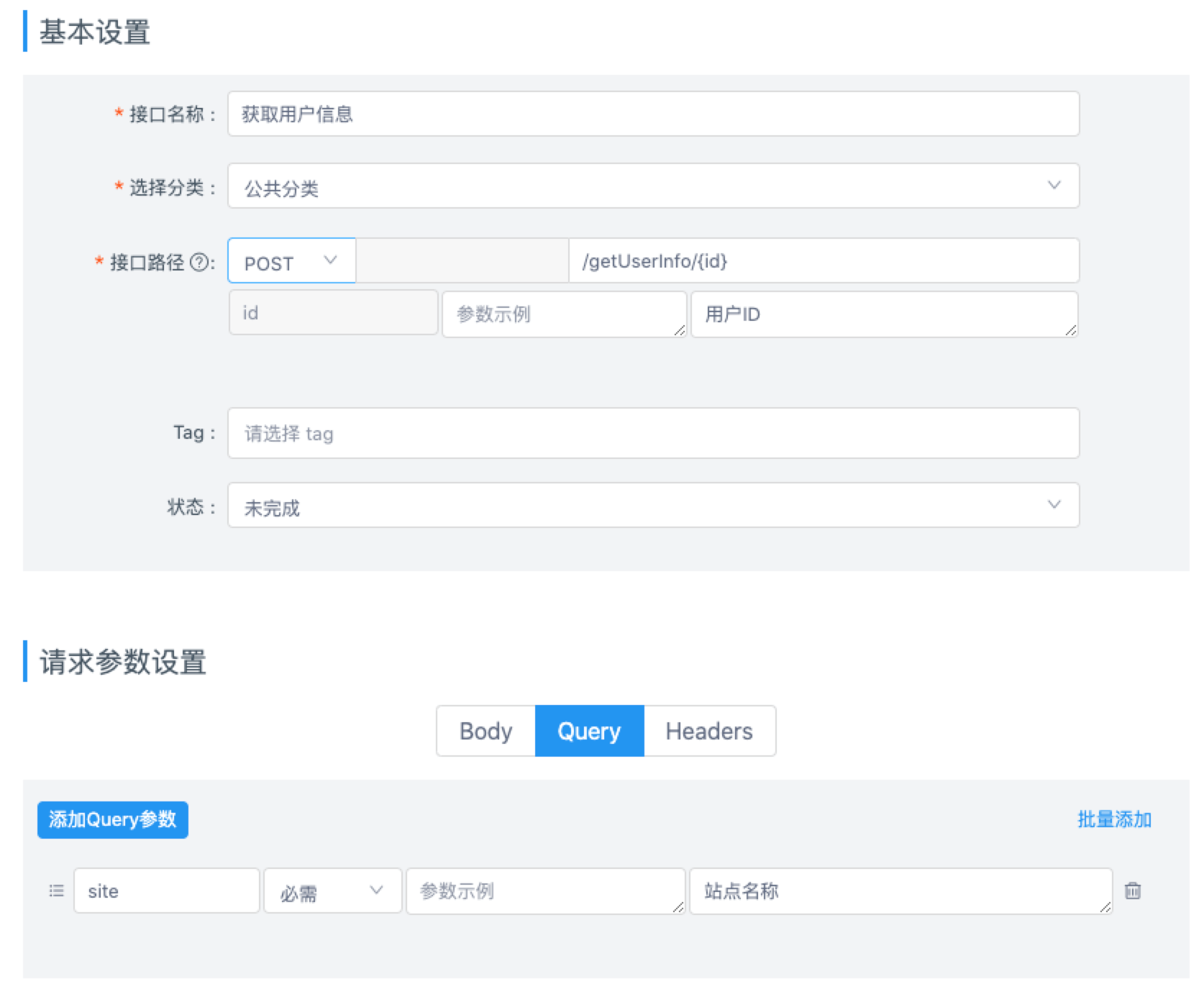统一请求函数
统一请求函数统一接收各个接口的配置,并返回具体接口的响应结果。
统一请求函数文件路径可通过 requestFunctionFilePath 配置,该文件必须导出一个统一请求函数。
如何编写
默认导出一个异步的请求函数即可:
import { RequestFunctionParams } from 'yapi-to-typescript'export default async function request<TResponseData>(payload: RequestFunctionParams,): Promise<TResponseData> {// ...// 基于 payload 获取接口信息,// 然后对接口发起请求,// 接着获取接口响应数据,// 并且根据 payload 的相关信息解析响应数据作为请求结果,// 最后返回请求结果。// ...}
如何获取接口信息
统一请求函数内可通过第一个参数 payload 获取接口信息。
mockUrl
- 类型:
string - 说明:
接口 Mock 地址,该地址根据接口 ID 自动生成,如:https://my.yapi.server/mock/993。
devUrl
- 类型:
string - 说明:
接口测试环境地址,该地址根据配置 devEnvName 拉取,如:https://my.dev.server/api/v2。
prodUrl
- 类型:
string - 说明:
接口生产环境地址,该地址根据配置 prodEnvName 拉取,如:https://my.prod.server/api/v2。
path
- 类型:
string - 说明:
接口路径,该路径以 YApi 上配置的接口路径为基准,首先将其中的路径参数替换为路径参数值,然后将接口的查询参数序列化为查询字符串附着在后面。举个例子:

对于上图所示的接口,如果你调用该接口请求函数时传参 { id: '120', site: 'weixin' },则 path 为:/getUserInfo/120?site=weixin。
method
类型:
'GET' | 'POST' | 'PUT' | 'DELETE' | 'HEAD' | 'OPTIONS' | 'PATCH'实际请这样使用:
import { Method } from 'yapi-to-typescript'console.log(Method.GET, Method.POST)说明:
请求方法。
requestHeaders 3.19.0+
类型:
Record<string, string>说明:
接口请求头,来自这里:

其中 Content-Type 会被去除。
requestBodyType
类型:
'query' | 'form' | 'json' | 'text' | 'file' | 'raw' | 'none'实际请这样使用:
import { RequestBodyType } from 'yapi-to-typescript'console.log(RequestBodyType.form, RequestBodyType.json)说明:
请求数据类型。
responseBodyType
类型:
'json' | 'text' | 'xml' | 'raw'实际请这样使用:
import { ResponseBodyType } from 'yapi-to-typescript'console.log(ResponseBodyType.text, ResponseBodyType.json)说明:
返回数据类型。
dataKey
- 类型:
string - 说明:
数据所在键,来自配置 dataKey。
paramNames
- 类型:
string[] - 说明:
路径参数的名称列表。一般不用关心,路径参数值已经被预处理进了 path。
queryNames
- 类型:
string[] - 说明:
查询参数的名称列表。一般不用关心,查询参数键值已经被预处理进了 path。
requestDataJsonSchema
- 类型:
JSONSchema4 - 说明:
请求数据的 JSON Schema,由配置 jsonSchema 开启。
responseDataJsonSchema
- 类型:
JSONSchema4 - 说明:
返回数据的 JSON Schema,由配置 jsonSchema 开启。
requestFunctionName 3.20.0+
- 类型:
string - 说明:
请求函数的名称。
data
- 类型:
object - 说明:
请求数据中的非文件数据。
hasFileData
- 类型:
boolean - 说明:
请求数据中是否包含文件数据。
fileData
- 类型:
object - 说明:
请求数据中的文件数据。
getFormData
- 类型:
() => FormData - 说明:
如果这是一个涉及文件上传的接口,可通过 getFormData() 获取到 FormData 直接上传,该 FormData 内已经添加了 data、fileData。
extraInfo 3.27.0+
- 类型:
Record<string, any> - 说明:
额外信息,由配置 setRequestFunctionExtraInfo 定义。
基于浏览器 fetch 的示例
下面是一个基于浏览器原生 fetch 的示例,通过 cross-fetch,你也可以让它运行在一些未实现 fetch 接口的老旧浏览器、Node.js、React Native 上。
import fetch from 'cross-fetch'import { RequestBodyType, RequestFunctionParams } from 'yapi-to-typescript'export interface RequestOptions {/*** 是否返回 Blob 结果,适用某些返回文件流的接口。*/returnBlob?: boolean}export enum RequestErrorType {NetworkError = 'NetworkError',StatusError = 'StatusError',BusinessError = 'BusinessError',}export class RequestError extends Error {constructor(public type: RequestErrorType,public message: any,public httpStatusOrBusinessCode: number = 0,) {super(message instanceof Error ? message.message : String(message))}}export default async function request<TResponseData>(payload: RequestFunctionParams,options?: RequestOptions,): Promise<TResponseData> {try {// 基础 URL,可以从载荷中拉取或者写死const baseUrl = payload.prodUrl// 完整 URLconst url = `${baseUrl}${payload.path}`// fetch 选项const fetchOptions: RequestInit = {method: payload.method,headers: {...(payload.hasFileData? {}: payload.requestBodyType === RequestBodyType.json? { 'Content-Type': 'application/json; charset=UTF-8' }: payload.requestBodyType === RequestBodyType.form? {'Content-Type':'application/x-www-form-urlencoded; charset=UTF-8',}: {}),},body: payload.hasFileData? payload.getFormData(): payload.requestBodyType === RequestBodyType.json? JSON.stringify(payload.data): payload.requestBodyType === RequestBodyType.form? Object.keys(payload.data).filter(key => payload.data[key] != null).map(key =>`${encodeURIComponent(key)}=${encodeURIComponent(payload.data[key],)}`,).join('&'): undefined,}// 发起请求const [fetchErr, fetchRes] = await fetch(url, fetchOptions).then<[// 如果遇到网络故障,fetch 将会 reject 一个 TypeError 对象TypeError,Response,]>(res => [null, res] as any,err => [err, null] as any,)// 网络错误if (fetchErr) {throw new RequestError(RequestErrorType.NetworkError, fetchErr)}// 状态错误if (fetchRes.status < 200 || fetchRes.status >= 300) {throw new RequestError(RequestErrorType.StatusError,`${fetchRes.status}: ${fetchRes.statusText}`,fetchRes.status,)}// 请求结果处理const res = options?.returnBlob? await fetchRes.blob(): (fetchRes.headers.get('Content-Type') || '').indexOf('application/json',) >= 0? await fetchRes.json()// 解析 JSON 报错时给个空对象作为默认值.catch(() => ({})): await fetchRes.text()// 业务错误// 假设 code 为 0 时表示请求成功,其他表示请求失败,同时 msg 表示错误信息if (res != null &&typeof res === 'object' &&res.code != null &&res.code !== 0) {throw new RequestError(RequestErrorType.BusinessError, res.msg, res.code)}// 适配 dataKey,取出 dataconst data: TResponseData =res != null &&typeof res === 'object' &&payload.dataKey != null &&res[payload.dataKey] != null? res[payload.dataKey]: resreturn data} catch (err: unknown) {// 重试函数const retry = () => request<TResponseData>(payload, options)if (err instanceof RequestError) {// 网络错误处理if (err.type === RequestErrorType.NetworkError) {// 此处可弹窗说明原因:err.message,最好也提供重试操作,下面以原生 confirm 为例,建议替换为项目中使用到的弹窗组件const isRetry = confirm(`网络错误:${err.message},是否重试?`)if (isRetry) {return retry()}throw err}// 状态错误处理else if (err.type === RequestErrorType.StatusError) {// 用户未登录处理if (err.httpStatusOrBusinessCode === 401) {// 推荐在此处发起登录逻辑}}// 业务错误处理else if (err.type === RequestErrorType.BusinessError) {// 推荐弹个轻提示说明错误原因:err.messagethrow err}} else {throw err}}}
基于小程序 request 的示例
下面是一个基于小程序原生 request 方法的示例,支持微信小程序、QQ 小程序、支付宝小程序、百度小程序、字节跳动小程序、钉钉小程序、京东小程序。
// TODO